Introduction
Experiences of journalists in the Vietnam War changed media reporting of wars today. The media reported uncensored events of the war to the public. These stories and photographs changed the public’s opinion about the war. The War took place between 1957 and 1975 in South Vietnam.
The Vietnam War claimed over 60,000 American soldiers and over 2 million Vietnamese. These figures are estimates as the exact number of casualties are extremely difficult to know. Arguably, this was the most unpopular war among Americans.
Critics and veterans believed that explicit and negative coverage of the war changed public opinion about it. Media have the capacity to shape opinions i.e. they can change the way we “think, feel, and react about situations and events” (Altheide, 2009).
This explains why the two iconic photos changed Americans view about the War. The first one depicts napalmed child (Accident Napalm of 1972). The second is the execution of an alleged Viet Cong soldier by an American marine in the street of Saigon (Tet Execution of 1968).
The review of literature and analysis shall show effects of the mass media on viewers and their views regarding the war. The analysis shall also involve common themes that emerged during the war due to media involvement and iconic photos that changed reporting style of subsequent wars.
These two photos reflect moments of horrors during the Vietnam War. Critics considered these images iconic because of emotions they created among American viewers.
In order to understand image representations of the Vietnam War, this study shall rely on semiotic analyses of photos through identifications of central ideas. We shall explore meanings behind photographs using signs and expressions, and how they relate to cultural aspects of society. Semiotic analyses enable us to understand meanings attributed to images and viewers’ perceptions of images in a given social context.
Different aspects of these photos can have different meanings to different people based on their cultural orientations. These iconic photos reveal the importance of photojournalism in reporting war events.
Reflexive-dialogic introduction
It is not possible to explain why the US government did not regulate media coverage of the Vietnam War. Americans watched all events of the war and viewed photographs obtained during the war. The media raised public concerns about the war and the rising number of casualties of the US soldiers.
The question is whether events of the Vietnam War created better opportunities for media reporters, photographers and commentators to question Americans involvement in the War.
The role of the media in the Vietnam War also raises issues of what the media ought to censor and report to the public. For instance, issues of Tet Offensive, Accidental Napalm, and other gruesome events that showed death and massive destruction created impressions that the Vietnam War was like that in Saigon and other areas.
It could be that media representations of the war angered soldiers. Soldiers believed that media had biased reporting especially in the Tet Offensive where the media portrayed that the US was losing the battle, and the only way out was to withdraw from the war. This is because a section of the media portrayed dead US soldiers killed during the war. This kind of reporting gave critics opportunities to accuse mass media of bias.
On the other hand, the media also claimed that they were reflecting perception of Americans regarding the war. Many issues could have changed Americans’ opinions about the war.
These could have been increases in taxes to cater for costs of the war and the rising number of casualties. These issues were influential during the war than media reporting. Critics wonder whether media undermined activities of soldiers and the government in the Vietnam War.
The clash between the military and the media is inevitable. The media need to report events as they are while the military focuses on winning the war and minimizing the number of casualties. Reporting these events means freedom, complete access to news, no censorship and rapid communications of news to the audience by media. Conversely, the military wants restricted access and control of information.
The media believe that attempts by the military to restrict access only aim at protecting their mistakes and enhancing their public image. These issues and differences remain crucial to relationships between the media and the military.
The media and military can work together. However, there is always a strange sense of animosity that can ruin such efforts of working together. This happens due to lack of understanding between the media and the military. Based on their opposing objectives and missions, the relationship between the media and military shall remain strained.
Literature review
In the beginning of the Vietnam War, many correspondents expressed their supports for the war. At the time, the media did not question the US involvement in the Vietnam War. In fact, the media roles were to inform the US public and portray positive sides of the war. However, this trend changed with the Vietnam War as reporters and photographs started questioning the US government intentions and its roles in the war.
The media focused on doubts and growing numbers of war casualties. As a result, the public changed its opinion about the war. Reporters and photographers portrayed sad pictures and horrifying scenes of the Vietnam War. According to Allen and Seaton, wrong representations of war by photojournalists can create confusion and misunderstanding among audience (Allen and Seaton, 1999).
These authors argue that media coverage is responsible for misunderstanding due to lack of adequate information. For instance, media portrayed that the US was losing the war and that there were increasing casualties and atrocities. Scholars have noted that this happened because of total freedom the media got in covering the Vietnam War and reporting what they wished.
This is how the media bias influenced Americans against the war. On the other hand, Allan highlights how the Vietnam War changed war reporting today.
This is what he refers to as objective reporting in the mass media (Allan, 2010). Allan looks at factors like cultural dynamism, racism, and sexism, and how they shape news reporting. The author also takes into consideration the role of various institutions, viewers, and practices of the media in reporting news.
As the media started to report atrocities of the war and its politics, the public confidence changed. Americans doubted the government’s account about the war. The media resorted to investigative journalism in order to ascertain facts behind news the government released to the public.
Before then, Allen and Seaton noted that media portrayal of wars fuelled hatred and ethnic loyalties. They also depicted how relying on vague and unfounded claims could trigger negative perceptions about the war (Allen and Seaton, 1999).
Photographs and reports played significant roles in changing the public opinion against the government and the war. Misrepresentation of information by the media led the public to believe that the US soldiers had lost the war. The media acted as crucial sources of information for the public. On this note, Altheide notes that mass media can shape the content and form of war experiences (Altheide, 2009).
Altheide focuses on mass media and their effects on propaganda, war on terrorism, and events after the 9/11 twin attacks. The author argues that it is fear that is responsible for the changing discourse and social meanings of wars. The author further looks at intervention strategies and how media stories influence future responses.
Following claims that the US could not win the War at Tet Offensive, the US government decided that the public should receive optimistic news. This marked the regulation of contents the public could access.
Since the US government did not censor news reporting, the public could receive photographs and live horrors of the war. People made films and accessed brutal images of the war. Photographs of the war shocked the general public and significantly shifted the people’s opinion against the war.
At the same time, “power of photography came to light, and how it could show brutality and assaults of the war” (Allan, 2010). Both still and moving pictures had significant influences about the horror of the war.
Whereas the Vietnam War representations in motion pictures took new turns with symbols, images, and metaphors, still pictures remained factual representations of the war. Consequently, scholars have studied major themes relating to social, political, and cultural meanings of these films (Auster and Quart, 1988).
The famous photo where General Nguyen Ngoc Loan executes a Viet Cong soldier in the street of Saigon (Tet Execution) has gained recognition over time. The General shot the soldier in a street before cameras. This photograph was responsible for increasing resentment among Americans about the war. This execution helped people change their opinions about the war and the role of the US government in the Vietnam War.
Another photograph of interest is the photo of “a nine-year-old girl fleeing naked and shouting after sustaining serious burn from the napalm” (Accidental Napalm 1972). There were also other photographs of massive influence. These included a photo of a Buddhist monk protesting against the war by burning himself to death, and at home, the Kent State University protest.
These photographs played crucial roles in bringing real images of the war to the public. Americans did not like what they saw on televisions and read on newspapers. Cottle observes that news and reporting are not neutral among different cultures. As a result, messages have cultural meanings and assumptions about various societies (Cottle, 2004).
Photographs are best forms of representations. However, in the modern time, influences of photographs representation in wars have stirred different political and ideological concerns. We cannot separate photograph representations from the culture of journalism and the public they serve.
Allen and Seaton note that media reporting should go behind ethnicity and relations to cultural context when reporting events (Allen and Seaton, 1999). They note that due to lack of sufficient information, the media may create misunderstanding. According to these authors, ethnicity is dynamic and has different constructions.
Contemporary society has come with methods of regulating access to information, pictures and films through rating their contents to different viewers. This is a way of creating and enhancing preferred values and ideologies among viewers.
However, restrictions of representations can achieve limited result. This is because images can have their own lives before the audience. In addition, they cannot have fixed and concrete meaning. Representations of images always create a gap between intended meanings and realized meanings.
From the above observation, we can note that representations may create errors, misunderstanding, and inconsistency. Thus, we cannot guarantee factual representations based on interpretation of signs in various cultures. According to Andersen, the relationship between the media and war is deep. She notes that the focus is on the public’s perception (Andersen, 2006).
Therefore, reporting helps in justification of wars and influence future wars. The author argues that war consists of “death and suffering, protest and pain, guilt and abuse and struggle for representation” (Andersen, 2006). However, this representation has changed over time as methods of reporting have changed, and censorship and propaganda have acquired new meanings.
The author argues that technology has transformed representation of war as the film industry has changed wars into forms of entertainment. On war and propaganda, Hammond notes that changes have occurred. He concludes that Western military operation has acquired new dimensions of representation using new technologies that promote propaganda (Hammond, 2007; Cottle, 2004).
In this view, Hammond notes that the media only serves to accelerate wars due to diverse misconceptions and political interests. The author also observes that power is at the central, and its projection leads to a lack of cohesion and orientation at home.
Anderegg and Grey looked at various films representing the Vietnam War and noted that such representations used myths and metaphors in order to reflect glamorised standards of Hollywood (Anderegg, 1991; Grey, 1992). Anderegg also noted that later representations of the Vietnam War strived to capture real events but with new twists and myths.
The author was keen on representations of issues regarding “power and powerlessness of victims and soldiers, gender roles, and racial views these films captured” (Anderegg, 1991). He also noted how teaching of the Vietnam War changed regarding contents and the intended audience.
Photographs acted as means of representing the war in Vietnam to Americans. The US public believed that photographs had accurate representations of the war. The reasons for the US withdrawal from the war may not be certain. However, it is clear that photos and live reporting of events significantly swayed the public opinion about the war.
Gilboa takes a cross-cultural look in an attempt to understand the relationship between media and wars. The author notes that media reporting is necessary in conflict management, resolution and transformation. In this case, the media influence conflict representation particularly with identity and ethnicity (Gilboa, 2002).
According to Der Derian, technology and video game industry have created flawed systems in real wars and responses (Der Derian, 2009; Franklin, 2000). According to the author, the US has blundered due to over reliance on technology, virtue, and threats of terror. He also notes that technological representations of wars depict a low risk affair. Representations of the Vietnam War took different aspects.
Hixson portrays various ways in which people have kept memories of the war (Hixson, 2000). However, these representations deviated from actual events as films begun to produce motion pictures for commercial purposes.
According to Sturken, representations of the Vietnam War and AIDS epidemic have transformed the US culture. The author looks at effects of camera images on cultural memory, media fantasy, trauma that survivors experience and how healing processes can smooth tensions. Scholars portray a culture of amnesia among Americans when it comes to recalling events of war (Sturken, 1997; Buzzanco, 1999).
Analytic section
From the Vietnam War, we can note three significant events. First, photojournalism changed the history of war reporting. Second, the media attempts to reveal the truth led Americans to doubt their government. Finally, televisions and photographs were significant in shaping the public’s perceptions about the war.
Critics believe that the media had a negative impact on Americans regarding the outcome of the Vietnam War. The media reporting portrayed images of horror that the public could not withstand. We must understand that the media supported this war during early stages of the US involvement.
However, television coverage and photographs changed Americans perception about the war. The biased reporting only concentrated on actions of the US soldiers and ignored atrocities that North Vietnam committed. As a result, the anti-war demonstrations gained the media attention.
Journalists and media pundits have debated the war reporting and its impacts on the public for many years. However, critics believe that it is only veterans who can give true accounts of the war.
This is because media main concerns are reporting events without understanding their meanings. As a result, war veterans believed that the television reporting distorted news by misrepresentation. For instance, they made the public believe that the US had lost the war while reality at the field was different.
Critics also believe that the media portrayed anti-war demonstrators as traitors. The media claimed that anti-war demonstrators were sympathizers of the US enemies. In addition, the media only concentrated on violet aspects of the anti-war demonstrations.
Critics believed that the media engaged in extremism so as to gain the public’s attention. As a result, the anti-war movement gained popularity through defiant definitions that various media portrayed.
This is manipulation of the media. It created a distant public from the government. The media ignored values and ideas the anti-war movement proclaimed. Instead, it concentrated on portraying violence associated with the protest.
Media scholars also believe that pessimistic war intentions did not originate from the media. This happened because the public did not understand the working style of the media. In fact, people believed that the media were mere transmitters of facts and news as they happened at the battle field.
In this regard, the critical role many scholars attribute to media is beyond their attention. Changes in reporting styles after the Tet Offensive simply reflected changes in events of the war, sources, and the government role in attempts to regulate contents. In addition, the media reporting of the anti-war movement showed that they were not responsible for actions of protestors.
Photographs have remained vital sources of information. Photographs are easier to recall than words. Images can influence or trigger different emotions in people. As a result, such emotions influence interpretation of photos. Influences of photos vary from individuals. However, scholars generally agree that photos have high capacity for memory, are less complex than words, and appeal to majorities.
People may debate on what features make images or photos iconic. The Accidental Napalm photo remains an iconic image of the Vietnam War. This is because the image of a naked running girl cannot easily disappear from Americans’ minds. This image shows cruelty of the war. This photo attained the status of an iconic image because everyone could recognize and understand it.
It captures a moment of history and creates a strong sense of emotions among audience. This photo had the capacity to ignite various views about the war. The media made the image and distributed it within their systems making the photo an icon. It created waves of negative reactions, prominence, subject of the war, and cultural aspects.
Accidental Napalm photo is an image reflecting the nudity of the burning and shouting girl. This photo violated cultural concerns about nudity in order to excite debate about immorality of the war. The public should not have access to this picture. It shows what we should not see and an event that should not have occurred. In views of feminists, the naked girl depicts a victimized female figure during wars.
This is to say it is the women and children who suffer in the event of any war. There is a clear difference between the soldiers walking and children running from terror. The image can also lead to question the responsibility of soldiers to children during times of wars.
The public cannot control their emotions when confronted with this photo. The photo evokes a sense of terror, pain, and pity. This photo remains the significant work of photojournalism in the history of war.
A semiotic analysis reveals that attentions of viewers are on the nude girl. The photo does not provide much detail. However, we can see that the war claimed the innocence of a young girl rendering her nude and powerless before the soldiers and photographers who captured her nudity.
The boy in the photo depicts terror of the war. All the children in this photo depict stiff contrast from the soldiers herding them down the street. It is also significant to note that these children do not have any parents in the photo. It remains unclear whether the war had claimed their parents.
The action of directing these children may show power of the soldiers over the war victims. The photo’s background shows thick and dark smoke. The dark smoke shows an image of threatening and risky situation during the battle.
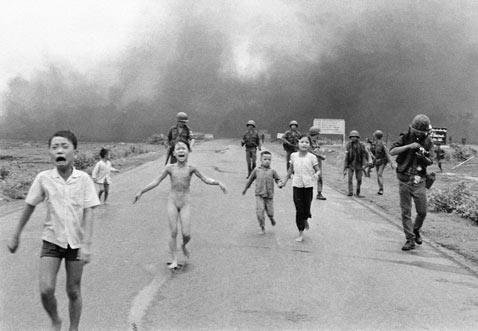
“The children from left to right are: Phan Thanh Tam, younger brother of Kim Phuc, who lost an eye, Phan Thanh Phouc, youngest brother of Kim Phuc, Kim Phuc, and Kim’s cousins Ho Van Bon, and Ho Thi Ting. Behind them are soldiers of the Vietnam Army 25th Division, June 8, 1972” (Nick Ut/AP Photo).
Another photo of interest is the Tet Execution. The photo shows General Nguyen Ngoc Loan as he shoots a captured Viet Cong enemy at a close range. The national televisions aired this execution. However, it is the still picture that grabbed the viewers’ attention.
The photo highlighted the facial expression of the war captive than did the live coverage of televisions. The photo became an iconic image because of the prominence and instantaneous influence it achieved. Still photos remain the most influential forms of representation in the world. The General and enemy only have a small gun between them.
The photo is simple, but it shows the reality of war i.e. man-to-man confrontation where the aggressor and enemy are face-to-face. This photo shows the real brutality of the Vietnam War. The General does not indicate any emotion. The act of executing enemies is normal to him. On the other hand, Viet Cong’s expression generates feelings of empathy among audience.

DURING: 1 February 1968 the national police chief of South Vietnam, General Nguyen Ngoc Loan shooting the enemy suspect in the head (Eddie Adams photo).
The photo of Tet Execution shows how photography achieved influence in the photojournalism. We cannot assume the fact that the General was aware of the presence of the camera. Thus, he turned his back to hide his feelings and purpose.
Conversely, we can see an expression of a man waiting for the unknown in the prisoner. The prisoner’s dress code and hair are the opposite of the General who expresses power in his military attire. The prisoner may not be a military officer after all. Instead, he might be a civilian experiencing the cruelty of the war. The General shows disregard for the normal justice system. This image only depicts hatred that exists among soldiers during wars.
The war depicted a show of power among soldiers (Anderegg, 1991). The General clearly expresses and flexes his muscles as he prepares to shoot his victim. On the other hand, the victim remains powerless since his hands are behind his back, tied thus, denying him the chance to defend himself.
The victim’s acceptance of his fate is evident in his motionless body. The prisoner knows it is pointless in trying to defend himself or escape. There is also a soldier who cannot believe the proceeding event. As a result, he is holding his teeth tightly because of this inhumane act. The soldier has protective helmet, unlike the Viet Cong captive.
This Tet Execution arouses feelings of empathy and portrays the General as a villain and the prisoner as a hero. We cannot completely understand circumstances of the photo. However, we can note that it is inhumane act against a helpless war victim. Therefore, the photo communicates the main act of war, which is to kill an enemy. As a result, viewers could experience atrocities that permeated the Vietnam War.
In the view of Donald and McDonald, the image of Tet Execution can have significant influence on reinforcing masculinity among boys (Donald and MacDonald, 2011).
The General’s victory over the victim can aid in reinforcing the male stereotype associated with combats and winning as these images are responsible for defining manly courage. Such images depicting the apotheosis of the US soldiers in wars are the current representations of the Vietnam War in various media as Slocum portrays (Slocum, 2006; Lembcke, 1998).
Conclusions
Various scholars have expressed their ideas about the relationship between the media and war. From this point, we can understand the impact of iconic images of the Vietnam War through semiotic analysis. These photos show general features of powerlessness, emotions, and innocence that were present in the Vietnam War.
We can now understand why these photos triggered emotions among American audience. The Accidental Napalm and Tet Execution arouse strong emotions of panic, fear, and pain among viewers making them iconic images of the war.
Semiotic analyses of these photos show that they are capable of arousing strong emotions among viewers. Viewers can easily relate these photos to distress, loss of lives, unpleasant experiences, and terror of the war. These photos are icons of outrage and atrocities of the war, and viewers not accustomed to such scenes can easily have negative emotions.
Photographs also captured innocence of the victims. These photos showed how innocent victims lost their lives during the war. The Tet Execution depicts the prisoner as an ordinary citizen and not an army officer. However, we learned that the victim was a Viet Cong soldier. The inhumane execution of this soldier shows disregard for the rule of the law and deviation from the concept of the war.
The Accidental Napalm shows the innocence of the children caught in the middle of the battle. The photo depicts how the war stripped the little girl’s innocence. The absence of any parent in the photo also raises concerns about the fate of these children. The war has left these children to fend for each other.
These photos also depict war victims who have no power to defend themselves. The Viet Cong is unable to defend himself against the General and soldiers. This sense of powerlessness reflects what the war has caused in South Vietnam.
The little girl also remains powerless to events taking place in her country. These photos remain crucial in representations of the Vietnam War. They also mark the role of photojournalism in depicting actual images of the war.
Reference List
Allan, S 2010, News Culture, Open University Press, New York.
Allen, T and Seaton, J 1999, The Media of Conflict: War Reporting and Representations of Ethnic Violence, Zed Books, New York.
Altheide, D 2009, Terror Post-9/11 and Media, Peter Lang, New York.
Anderegg, M 1991, Inventing Vietnam: The War in Film and Television, Temple University Press, Philadelphia.
Andersen, R 2006, A Century of Media, a Century of War, Peter Lang, New York.
Auster, A and Quart, L 1988, How the War was Remembered: Hollywood and Vietnam, Praeger, New York.
Buzzanco, R 1999, Vietnam and the Transformation of American Life, Blackwell Publishers, Malden.
Cottle, S 2004, News, Public Relations and Power, Sage, London.
Der Derian, J 2009, Virtuous War: Mapping the Military-Industrial-Media- Entertainment Network, 2nd edn, Westview Press, Colorado.
Donald, R and MacDonald, K 2011, Reel Men at War: Masculinity and the American War Film, Scarecrow Press, Lanham MD.
Franklin, B 2000, Vietnam and Other American Fantasies, University of Massachusetts Press, Amherst.
Gilboa, E 2002, Media and Conflict: Framing Issues, Making Policy, Shaping Opinions, Transnational, Ardsley, NY.
Grey, J 1992, Vietnam: War, Myth and Memory: Comparative Perspectives on Australia’s War, Allen & Unwin, St Leonards.
Hammond, P 2007, Media, War and Postmodernity, Routledge, London.
Hixson, W 2000, Historical Memory and Representations of the Vietnam War, Garland Publishers, New York.
Lembcke, J 1998, The Spitting Image: Myth, Memory, and the Legacy of Vietnam, New York UP, New York.
Slocum, D 2006, Hollywood and War, The Film Reader, Routledge, London.
Sturken, M 1997, Tangled Memories: The Vietnam War, the AIDS Epidemic, and the Politics of Remembering, University of California Press, Berkeley.
Appendices
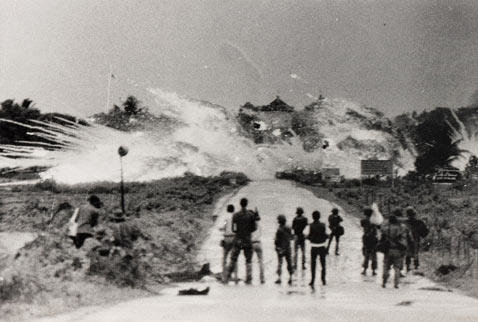
Bombs with a mixture of napalm and white phosphorus jelly dropped by Vietnamese Air Force Skyraider bombers explode across Route 1, amid homes and in front of the Cao Dai temple on the outskirts of Trang Bang, Vietnam, June 8, 1972. (Nick Ut/AP Photo)

Nick Ut took this image seconds after his famous shot, of Kim Phuc running down the street. Television crews and South Vietnamese troops surround 9-year-old Kim Phuc on Route 1 near Trang Bang, South Vietnam, after she was burned by a misdirected aerial napalm attack, June 8, 1972. (Nick Ut/AP)
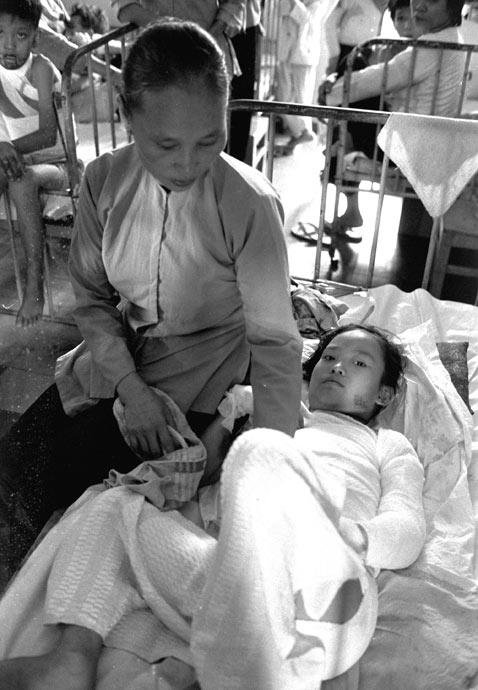
Phan Tai Kim Phuc, 9, is comforted by her mother in a Saigon, Vietnam, hospital, two days after she was severely burned during a misplaced napalm attack on her village, June 10, 1972.(Robinson/AP Photo)
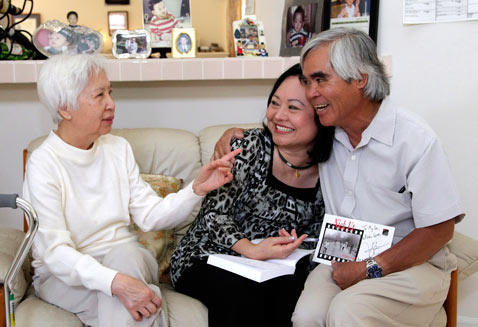
From right, Associated Press staff photographer Nick Ut, Phan Thi Kim Phuc and Dr. My Le, who treated Kim Phuc two days after a napalm attack in Vietnam 40 years ago, sit together during a reunion in Buena Park, Calif., June 2, 2012. (Jae C. Hong/AP Photo)

Britain’s Queen Elizabeth II, right, opens the new Welcome Wing of London‘s Science Museum with Associated Press photographer Nick Ut, left and Phan Thi Kim Phuc, centre, June 27, 2000. Ut’s image of Kim is featured in the museum. (Ian Jones/AP Photo)
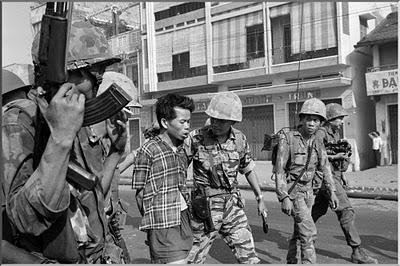
BEFORE: South Vietnamese forces escort suspected Viet Cong officer Nguyen Van Lem (also known as Bay Lop) on a Saigon street Feb. 1, 1968, early in the Tet Offensive. (AP Photo/Eddie Adams
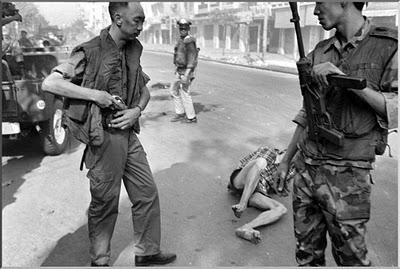
AFTER: The victim falls dead on the ground and police chief calmly puts the gun back
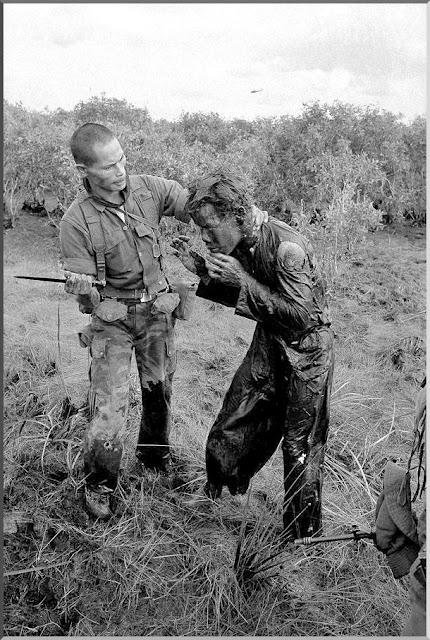
January 9, 1964 a soldier of the Army of South Vietnam stabs a farmer, assuming that he was lying on the movements of the Viet Cong – North Vietnamese soldiers. (AP Photo/Horst Faas)